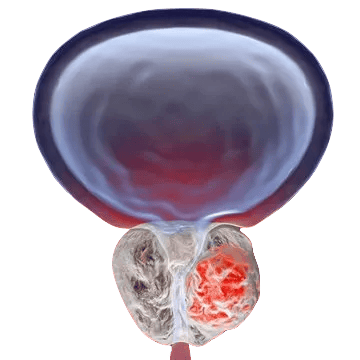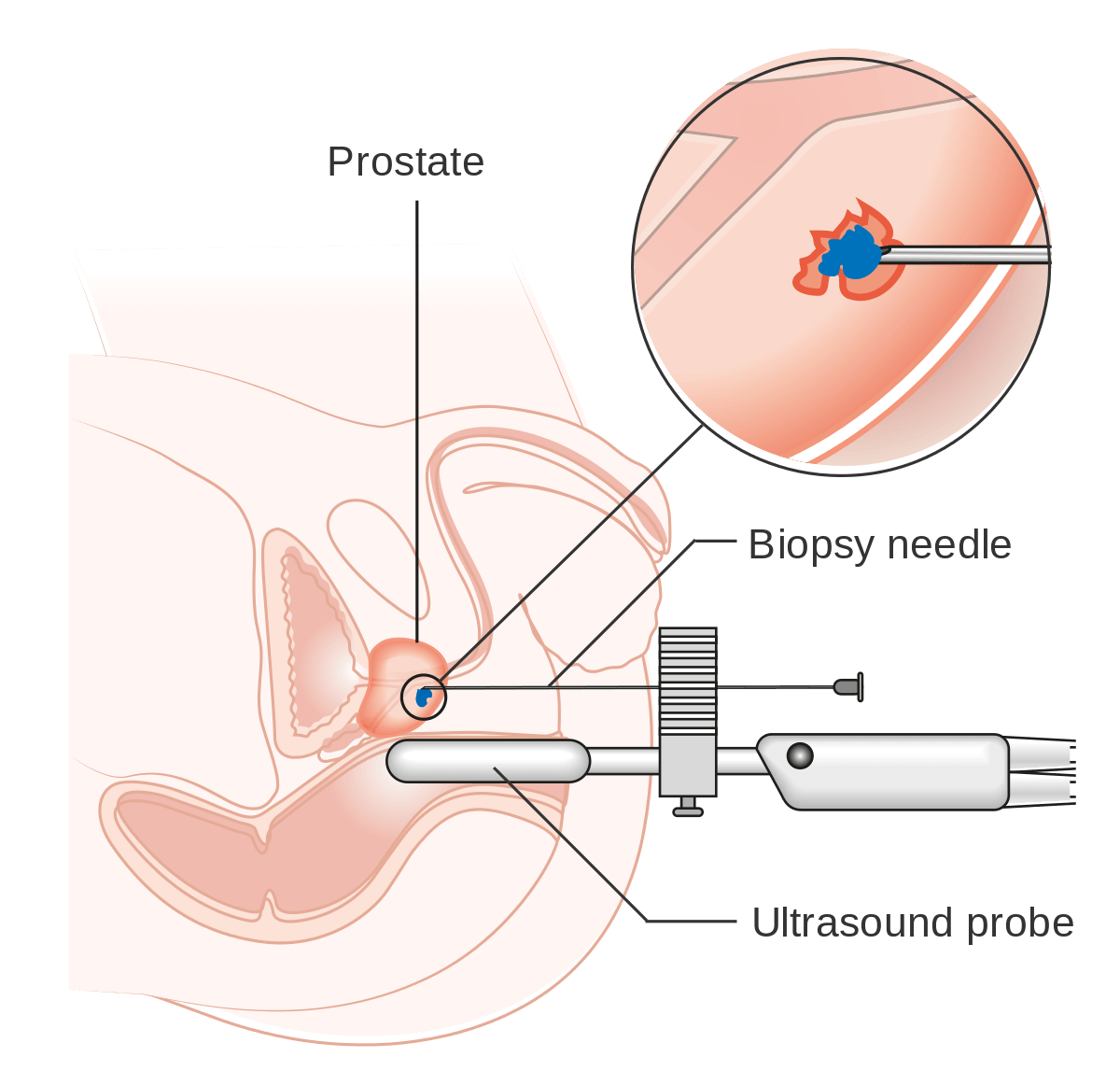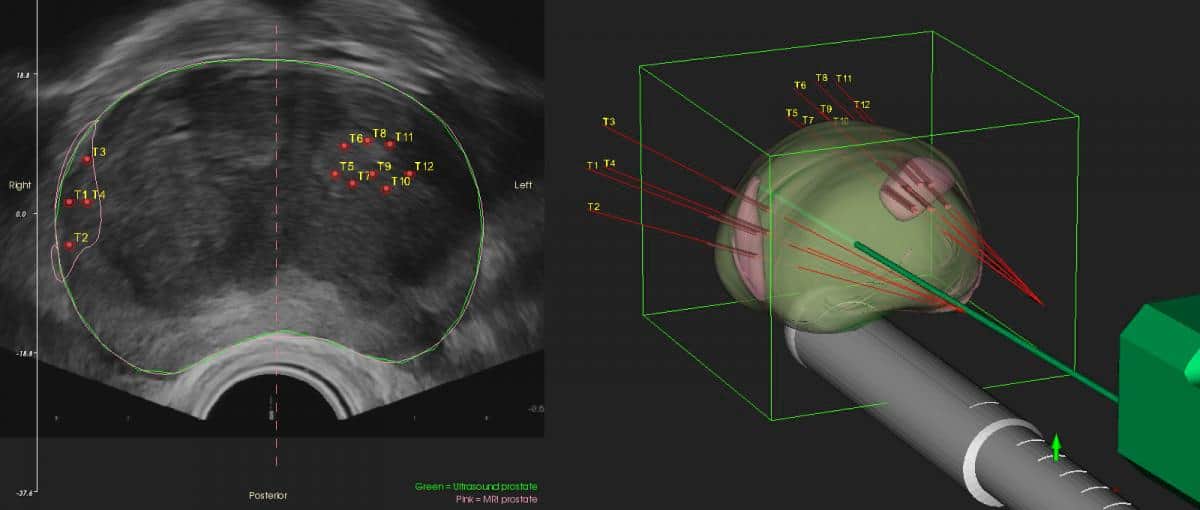Prostate Cancer
What is Prostate Cancer?
The prostate gland is a secretory gland situated around the bladder neck, releasing seminal fluid to transport sperm.
Prostate cancer is a type of cancer that occurs in the prostate. It is one of the most common types of cancer in men, and the risk of developing it increases with age.
While many men die “with” prostate cancer rather than “of” prostate cancer, it is essential to note that more men die of prostate cancer each year in Australia than women die of breast cancer.

How Does Prostate Cancer Impact Anatomy and Health?
Prostate cancer can impact the anatomy and health of a person in several ways:
- Urinary symptoms
- Sexual symptoms
- Pain or discomfort
- Bone pain
- Fatigue
- Loss of appetite and weight loss
- Spread of cancer
- Metastasis: Prostate cancer that has spread to other body parts is called metastatic prostate cancer.
Types of Prostate Cancer
Prostate cancer can be classified into different types based on the appearance of the cancer cells and how aggressive the cancer is. The main types of prostate cancer are:
- Adenocarcinoma is the most common type of prostate cancer, accounting for more than 90% of cases. It starts in the prostate glandular cells and can be classified as well-differentiated, moderately-differentiated, or poorly-differentiated.
- Small cell carcinoma: This rare type of prostate cancer is more aggressive and spreads quickly to other body parts.
- Squamous cell carcinoma: This is a rare type of prostate cancer that starts in the flat, scale-like cells of the prostate.
- Transitional cell carcinoma: This rare type of prostate cancer starts in the cells lining the prostate and the urethra.
Some prostate cancer may have features of multiple types and, therefore, may be difficult to classify. Also, prostate cancer may have different subtypes, like neuroendocrine prostate cancer, a rare subtype that tends to be more aggressive.
Who Does Prostate Cancer Affect?
Prostate Cancer occurs only in men and is more common in men who are older than 50 years, but it can occur in younger men, especially if there is a strong family history. Therefore, testing for prostate cancer should begin at age 50, or from 40-45 years of age, depending on risk factors.
Positive family history on the father’s side (father, paternal uncles, brothers) is the leading risk factor and is more likely to result in more advanced cases of malignancy. Also, a strong family history of breast, ovarian or pancreatic cancer may indicate the presence of a BRCA gene defect, another risk factor.
The rate of prostate cancer also varies with race, with Asians having the lowest incidence and Caucasians, Hispanics and Blacks having higher incidence rates. However, Asians adopting the Western lifestyle have been shown to carry a higher risk of prostate cancer.
How Does Prostate Cancer Occur?
When the cells in the prostate gland become abnormal, this results in the uncontrolled division in the mutated cells, forming a tumour made up of the abnormal cells, which continue to grow and spread to surrounding tissues and potentially to the rest of the body.
Causes of Prostate Cancer?
The exact cause of prostate cancer is not known, but several factors have been linked to its development, including:
- Genetics: Certain genetic mutations may increase the risk of prostate cancer. Men with a family history of prostate cancer are more likely to develop the disease.
- Hormones: Prostate cancer cells need androgens, specifically testosterone, to grow. The link between hormones and prostate cancer is not fully understood, but it is believed that higher levels of testosterone may increase the risk of developing the disease.
- Age: The risk of developing prostate cancer increases as men get older, with most cases occurring in men over 65.
- Diet: A diet high in red meat and saturated fat may increase the risk of prostate cancer.
- Exposure to certain chemicals: Certain chemicals, such as pesticides and cadmium, may increase the risk of prostate cancer.
- Inflammation: Long-term prostate inflammation has been linked to an increased risk of prostate cancer.
- Lifestyle factors: smoking, obesity, lack of physical activity, and high alcohol intake are lifestyle factors that may increase the risk of prostate cancer.
Symptoms of Prostate Cancer
Prostate cancer symptoms may not be present in the early stages of the disease. As cancer grows, symptoms may include:
- Difficulty urinating
- Frequent urination, especially at night.
- Pain or discomfort while urinating.
- Blood in the urine or semen.
- Pain or discomfort in the pelvic area, back or hips.
- Erectile dysfunction: difficulty achieving or maintaining an erection.
- Bone pain: cancer may spread to the bones, causing pain and weakness.
- Loss of appetite and weight loss.
Additionally, men with advanced or metastatic prostate cancer may experience additional symptoms such as:
- Fatigue
- Weakness
- Swelling in the legs or feet
- Lumps or masses in the pelvic area
- Nerve problems, such as numbness or weakness in the legs
- Bowel or bladder incontinence
- Loss of bladder or bowel control
What are the Stages of Prostate Cancer?
The stage of prostate cancer refers to how advanced the cancer is and how far it has spread. The central staging systems for prostate cancer are the Gleason grading system and the TNM system.
Gleason Score for Prostate Cancer
Historically, a scale called the Gleason score is used for this, which gives a score out of 10. Prostate Cancer can be graded based on its aggressiveness and spread.
Oddly, the lowest possible number is a score of 6 which means the cancer is non-aggressive. A score of 7 indicates intermediate cancer, and scores of 8-10 mean it’s very aggressive.
The Gleason score is now replaced with a more straightforward system called the ISUP (International Society of Uropathologists) classification. This system is based on the Gleason score as follows:
- ISUP 1 - Gleason Score 3+3 = 6
- ISUP 2 - Gleason 3+4 = 7
- ISUP 3 - Gleason 4+3 = 7
- ISUP 4 - Gleason Score 8
- ISUP 5 - Gleason Score 9,10
Nowadays, ISUP is preferred due to its simplicity and less anxiety for patients.
TNM Staging of Prostate Cancer
TNM staging describes how far cancer has spread within and beyond the prostate capsule. In cases where there are no distant secondaries and where curative treatment is being considered, the T stage is critical:
- T1: The tumour is confined within the prostate, and the prostate feels normal. It is usually diagnosed based on a raised PSA.
- T2: Tumour is confined to the prostate, but the prostate feels irregular to examination
- T3: Tumour has spread just beyond the shell of the prostate into nearby tissue and the seminal vesicles at the back of the prostate gland.
- T4: Tumour has spread into adjacent organs such as the bladder, rectum, or pelvic side wall.
Prostate cancer can also spread to lymph nodes (N stage) and other body parts, such as bone and other organs, as metastases (M stage).
Prostate cancer does not typically produce symptoms until it is advanced. This is why men need to get PSA tests, as this is the primary way prostate cancer will be diagnosed before it has spread.
How is Prostate Cancer Diagnosed?
The prostate cancer foundation of Australia (PCFA) and Cancer Council Australia recommend regular PSA screening of healthy men over 50.
Earlier PSA screening at the age of 45 is recommended if the risk of prostate cancer is increased (i.e. family history), as early prognosis is crucial for a more positive outcome.
Some men present with urinary symptoms that could be related to prostate cancer. However, these symptoms are much more likely due to enlarged prostate (BPH) unless prostate cancer is at an advanced stage.
Screening involves a Prostate Specific Antigen Test +/- Digital Rectal Examination.
If these tests yield abnormal results, to confirm malignancy and its stage Dr Wang will consider any of the tests listed below:
- Multiparametric prostate MRI
- Prostate Biopsy
- Cystoscopy
- PSMA PET Scan
- Urinary Flow or Urodynamic Testing
- Other Imaging Tests
Prostate-Specific Antigen (PSA) Test
Prostate Specific Antigen is a substance produced almost exclusively in the prostate and plays a role in fertility.
The vast majority is released into the ejaculate, but tiny amounts are released into the bloodstream and can be detected by a simple blood test. Abnormally high levels of PSA can be an indication of a disease of the prostate.
Common reasons for a high PSA level in the bloodstream may include the following:
- Prostate cancer,
- Large prostates, and
- Age-related inflammation of the prostate
- Infection of the prostate
- Ejaculation, or cycling
The first concern is to exclude prostate cancer. A urologist review is advised to exclude this.
Digital Rectal Examination (DRE)
The bladder is the organ that stores urine, and the urethra is the tube that drains urine out through the penis. The prostate lies immediately beneath the bladder, surrounds the urethra, and lies immediately in front of the rectum (back passage).
Dr Wang would typically perform a Digital Rectal Examination (examination via the back passage) of the prostate, an otherwise inaccessible internal organ.
During a DRE, Dr Wang gently inserts a gloved finger into the rectum to feel the condition of the prostate that lies close to the rectal wall. Further tests will be carried out if he feels something suspicious, such as a lump or bump.
Age-related enlargement is not a particular concern, but if the gland feels abnormally firm or hard, it may sometimes indicate abnormal growth in the prostate gland.
Dr Wang will discuss the test results with you. Further tests will be required if anything suspicious is detected, such as a lump or irregularity, during the exam.
After the test, you may continue your normal activities.
Prostate Biopsy
This test is commonly performed because a blood test called PSA is abnormally high or the prostate's DRE is abnormal.
More commonly nowadays biopsy is performed after an MRI of the prostate shows suspicion of prostate cancer. There are mainly two approaches.
- Transrectal biopsy - This was the most commonly performed technique. The biopsy needle is passed through the rectum into the prostate. It is quicker and does not need a general anaesthetic. However, due to the risk of severe infective complications, Dr Wang does not advocate for this.
- Transperineal biopsy - This new technique involves passing the biopsy needle through the perineum, the area between the scrotum and the anus. This approach is associated with less infection and allows more accessible sampling in the anterior part of the gland. In addition, more cores can be taken compared to the transrectal biopsy, which means that the results can potentially be more accurate. However, it often involves a general anaesthetic, takes longer and may be associated with more short-term urinary flow problems.
Dr Wang performs transperineal biopsy in many different ways (including MRI fusion technology which would help to target the area of concern) to facilitate diagnostic accuracy.
Cystoscopy
Cystoscopy lets a urologist directly view the inside of the urinary bladder and urethra in great detail using a "cystoscope" (the instrument used). There are two types of cystoscopes.
Rigid Cystoscope - This solid straight telescope uses a high-intensity light source. A separate channel allows other instruments to be attached.
Flexible Cystoscope - It is a fibre optic instrument that can bend easily and has a manoeuvrable tip that makes it easy to pass along the curves of the urethra.
Urinary Flow Test
A Urinary Flow Test, also known as Urinalysis, is a test of your urine. Urinalysis is used to determine the presence of leukocytes (white blood cells) in the urine. Leukocytes help the body to fight infection; a high number indicates a bacterial infection. A urine culture is used to analyse bacteria.
Radiology
Ultrasound - Ultrasound of the prostate uses sound waves to produce pictures of a man's prostate gland and to help diagnose symptoms such as difficulty urinating or an elevated blood test result.
Magnetic Resonance Imaging (MRI) - Prostate MRI is a non-invasive imaging technique. This test is similar to a CT scan but uses magnetism instead of X-rays to build fine cross-sectional pictures of your body. Multiparametric prostate MRI (mpMRI) is an excellent diagnostic adjunct to the evaluation of prostate cancer.
A Prostate Imaging Reporting and Data System (PIRADS) score provides the likelihood of clinically significant prostate cancer.
Second Tier Investigations
If clinically significant prostate cancer is diagnosed, Dr Wang will arrange a staging scan to ensure no evidence of metastasis (spread outside the prostate gland).
Conventionally CT and bone scans are performed.
PSMA PET scan is more accurate in diagnosing any area of metastasis (spread) than a CT and bone scan. Dr Wang will go through the pros and cons of each and arrange an appropriate scan.
CT Scan - A CT Scan is an X-ray tube that rotates in a circle around the patient and takes pictures as it turns. A computer reconstructs multiple X-ray pictures in axial slice images at different levels. Each level can be examined separately.
A CT scan may show if cancer has spread beyond the Prostate to other parts of the body, such as the lymph nodes.
Nuclear Bone Scans are used to see if the disease or cancer has metastasised and has affected your bones.
This scan can also detect other conditions affecting the bones, such as arthritis.
Further imaging studies, such as CT/MRI/PSMA scan of any suspicious area, may be necessary for increased accuracy.
Gallium-68 PSMA PET Scans - A small amount of radioactive material is injected into your arm. The radioactive marker then binds to Prostate Cancer Cells. It combines Positron Emission Tomography (PET) and CT Scanning technology.
You will then be scanned an hour later to help identify areas where Prostate cancer may have spread to.
This is a reasonably new scan, but its accuracy has been demonstrated to be superior to conventional CT and bone scans.
How is Prostate Cancer Treated?
Treatment options for prostate cancer depend on the stage and grade of cancer, the patient's overall health and personal preferences. Some standard treatment options include:
- Surgery: The most common surgical procedure for prostate cancer is a radical prostatectomy, which involves removing the entire prostate and some surrounding tissue.
- Radiation therapy: This treatment uses high-energy rays to kill cancer cells. It can be delivered externally using a machine called a linear accelerator or internally using a small radioactive source called a seed implant.
- Hormone therapy: This treatment aims to lower the level of testosterone in the body, as prostate cancer cells need testosterone to grow. This can be done by administering drugs that block the production of testosterone or by surgically removing the testicles.
- Chemotherapy: This treatment uses drugs to kill cancer cells. It is often used for men with advanced prostate cancer that has spread to other parts of the body.
- Active surveillance: This option is chosen by some men with low-risk prostate cancer. It involves monitoring cancer closely with regular PSA tests, DRE and biopsy but avoiding treatment until the cancer progresses and becomes a higher risk.
- Cryotherapy: This treatment uses extreme cold to destroy cancer cells. It is performed under general anaesthesia and can be used to treat early-stage prostate cancer. This option is still considered experimental and only indicated in very selective patients.
- Immunotherapy aims to help the body's immune system fight cancer cells. It's a relatively new treatment option, and it's only available for some advanced stages of prostate cancer.
What if Prostate Cancer is Untreated?
If prostate cancer is not treated, it can grow and spread to other body parts. Over time, it can cause severe complications and may become life-threatening.
Prostate cancer can be treated successfully if it is caught early. Regular screenings and early detection can help ensure that the cancer is detected before it becomes advanced and more challenging to treat. If you have any symptoms or risk factors for prostate cancer, it's essential to talk to your doctor and undergo regular screenings.








